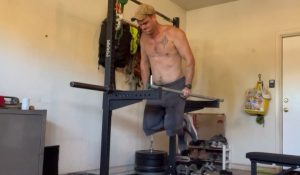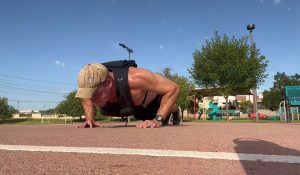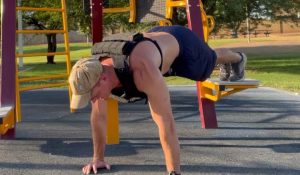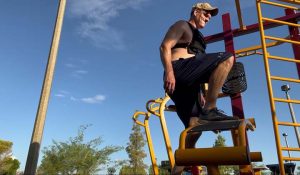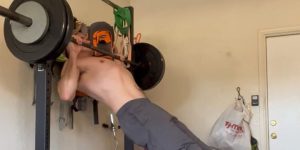If you ask most folks (including trainers) how to utilize push-ups to develop the upper chest, you’ll hear one thing over and over: decline push-ups. However, this advice is only useful if you understand how to actually do the exercise to bias upper chest fiber recruitment.
In this article, we’re going to discuss my top 3 form cues to actually target the upper chest with push-ups, whether you’re doing them on a decline or not.
The problem with “just do decline push-ups”
If you’re doing your decline push-ups in such a way that you’re simply placing your chest on the ground at the end of the rep, you’re not actually biasing the upper chest at all, since the angle of pressing is still flat.
You’re simply increasing the load, creating the functional equivalent of a weighted push-up. This is not bad, per se, it’s just not what we’re going for.
This is the reason that most folks who just try to do decline push-ups for upper chest don’t feel that it actually works. We have elevated our feet, but we haven’t actually changed the angle of the press.
The best push-up for upper chest
Below, I’ll go through three tips that will help you target the upper chest with the humble push-up. However, be warned:
Folks looking for the “best” push-up to do for upper chest gains are asking the wrong question. It’s not what variation you do, but your intention in the press and how you do it.
This is the real reason most folks upper chest development lags isn’t because they’re doing the wrong exercise. It’s just extremely hard to develop a mind-muscle connection to the upper chest muscles.
They are small and surrounded by large muscles of the upper body that will take over in an instant if you let them.
Allow me to explain with my top three form cues to anyone looking to bias their chest workout toward upper chest muscle and strength:
Tip #1: Elevate your butt slightly on push-ups
While some folks may not see the nuance of this form change, it’s actually the key to making the push-up work for upper chest development. We need to actually decline the angle of the torso to the ground, and then maintain that angle throughout the entirety of the rep.
The image below should illustrate this “butt elevated” technique. Though it’s slight, it makes the push-up harder. More importantly, it can actually be felt in the clavicular head of the pectoral muscle. In fact, it’s so slight that the uninitiated may even yell at you for doing your push-ups “wrong.” But it works.
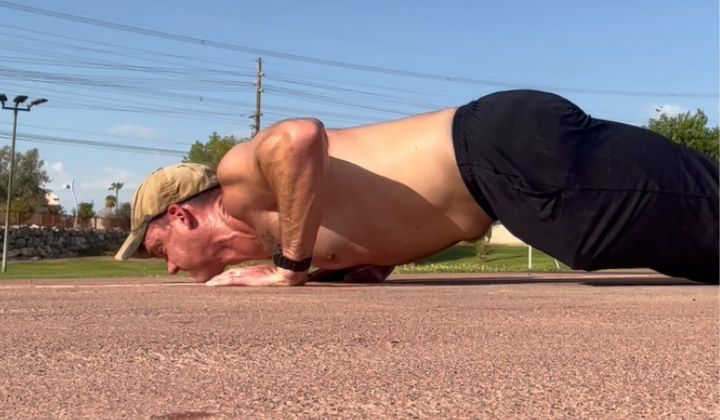
The form cue I’m looking for here is that I want my chin to brush the ground while my chest is still a couple of inches off the ground. That tells me that I’ve got the correct angle. This creates the functional equivalent of a “low-incline” bench press angle.
I want to maintain that angle throughout the entirety of the descent, and the press.
Tip #2: Narrow your grip
It has been argued that the diamond push-up is actually the push-up variation that stresses the clavicular head of the pec the most. Ironic, since this variation is famous for being ideal for stressing the triceps more than the chest.
While it’s true that the diamond push-up does involve the clavicular head to a greater extent than the sternocostal head, I personally believe that widening the grip slightly to shoulder width is actually better. This is for a couple of reasons:
- Diamond push-ups place so much emphasis on the triceps that you may find it difficult to actually bring the pectorals within a few reps of failure, which defeats the point, and
- Diamond push-ups can tend to bother people’s wrists more than other push-up variations (your milieage may vary here).
If you’ve got triceps and wrists of steel, then the above considerations may not mean anything to you. However, for most people, I think we’d be better served by simply widening the grip to shoulder width.
The shoulder-width grip allows us to achieve the optimal angle (45 degrees or less) between the humerus and torso to stress the clavicular head properly, while not trashing our triceps so badly that we can’t finish the set.
Tip #3: Press Upward and Inward
If you’re familiar with the popular techniques for developing a mind-muscle connection with the clavicular head of the pec, then this won’t come as a surprise to you. However, if you’ve never tried this before, you may be surprised at how different this feels.
I’ll attempt to illustrate with an image:

As we press, imagine that you’re trying to bring your hands together, and to elevate them at the same time. I like to think of aiming at a certain spot on the ground, in a straight line directly below my nose.
Of course, our hands are stuck to the ground for the entire repetition and they shouldn’t actually move. But the intention of moving the hands upward and inward will immediately fire up the fibers of the upper chest.
Addressing range-of-motion concerns
You’ll notice from the above pictures that my chest actually doesn’t touch the ground. This is done on purpose to maintain the angle. However, the astute among you will raise a valid concern:
Why would you want to limit the range of motion in the most hypertrophic portion of the rep (the stretched portion)?
Great question! First, I would argue in this case that hitting the target muscle is more important than being militant about range-of-motion concerns. However, if you must fix the issue:
- Elevate your hands on weight plates (if you’re in a gym)
- Use push-up handles (if you’re at home)
- Man up and do the push-ups on your knuckles!
A $10 set of parallettes that I’ve had for probably 8-9 years makes quick work of this problem:
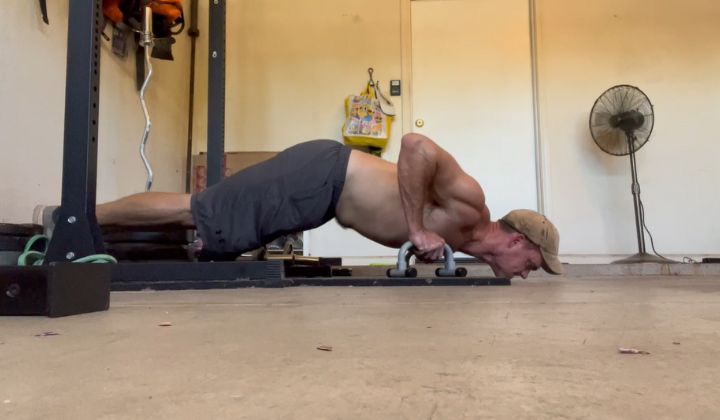
Any of these three fixes should eliminate any range of motion concerns, as well as allow you to modulate the end range to the individual tolerances of your specific shoulders.
Don’t be surprised if the number of reps you can do tanks
I’ll leave you with this – don’t be surprised if the number of repetitions you can do in a given set of push-ups tanks by 50-60%. If you’ve never specifically targeted this portion of the chest successfully, this is to be expected.
You are targeting an untrained muscle. It is weak.
For this reason, the number of repetitions you can do per set should be significantly less. Resist the urge to drop your butt back down in order to get more reps. Keep the angle the same, keep the hand placement narrow, and keep pressing the hands together and upward.
When the target muscles have had enough, you’ll know it. Stop your sets once you’re down to 1-2 repetitions left “in the tank”, rest 2-3 minutes, and try again. Add weight to your pushups, if possible.
Lastly, be patient
There’s a reason that lifters wax poetic about their lack of upper chest gains repeatedly. Long after most individuals have bulging quads, lats, and lower pecs, the upper chest is a source of consternation for many.
Give it time. It’s a small muscle that makes a large visual impact. 3-6 months of focused effort should be enough to see a difference, but a year or more is likely what you really need if you want to bring up this area.
Muscles grow slowly. You just have to be willing to be more stubborn than they are!
Good luck!













